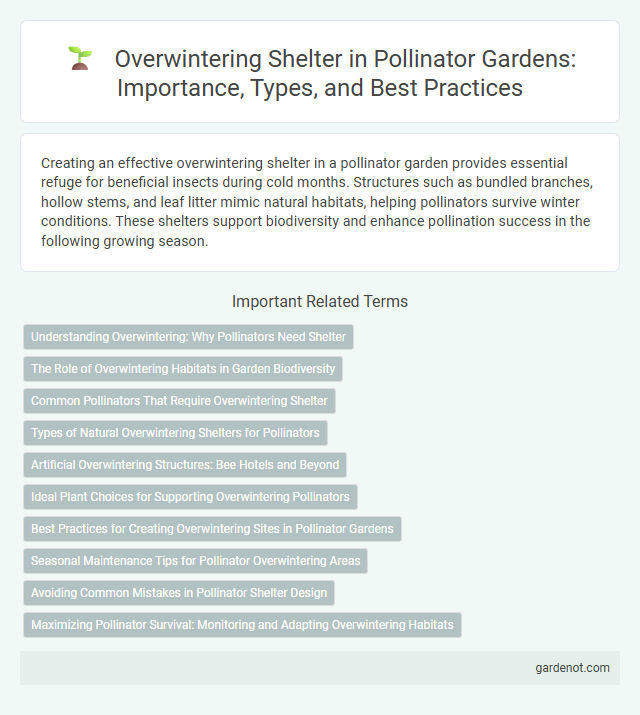Creating an effective overwintering shelter in a pollinator garden provides essential refuge for beneficial insects during cold months. Structures such as bundled branches, hollow stems, and leaf litter mimic natural habitats, helping pollinators survive winter conditions. These shelters support biodiversity and enhance pollination success in the following growing season.
Understanding Overwintering: Why Pollinators Need Shelter
Pollinators require overwintering shelters to survive cold months when food sources are scarce and temperatures drop below freezing. These shelters provide insulated environments that protect insects like bees, butterflies, and beetles from harsh weather and predators, ensuring their survival until spring. Creating diverse habitats with leaf litter, hollow stems, and brush piles is crucial for maintaining healthy pollinator populations year-round.
The Role of Overwintering Habitats in Garden Biodiversity
Overwintering shelters provide essential habitats where pollinators like bees, butterflies, and beetles can survive harsh winter conditions, maintaining their populations for the upcoming growing season. These habitats increase garden biodiversity by supporting various species' life cycles, ensuring pollination and ecosystem stability. Incorporating leaf litter, hollow stems, and brush piles into pollinator gardens enhances these shelters' effectiveness in promoting healthy pollinator communities.
Common Pollinators That Require Overwintering Shelter
Common pollinators such as bumblebees, mason bees, and certain butterfly species rely on overwintering shelters to survive harsh winter conditions. These insects seek refuge in hollow stems, leaf litter, and specially designed bee hotels that provide insulation and protection from predators. Ensuring the availability of suitable overwintering habitats within pollinator gardens is crucial for maintaining healthy pollinator populations year-round.
Types of Natural Overwintering Shelters for Pollinators
Natural overwintering shelters for pollinators include leaf litter, which provides insulation and protection for solitary bees and butterflies; hollow stems from plants like goldenrod and raspberry, offering cozy nesting sites for mason bees; and dead wood or logs, harboring bumblebee queens and beetles during colder months. These habitats maintain stable microclimates essential for pollinator survival and support biodiversity in garden ecosystems. Preserving diverse vegetation and avoiding garden cleanup in late fall enhances the availability of these critical overwintering sites.
Artificial Overwintering Structures: Bee Hotels and Beyond
Artificial overwintering structures, such as bee hotels, provide essential habitats for solitary bees and other pollinators to survive cold seasons by offering insulated nesting sites protected from predators and harsh weather. These shelters, constructed from materials like bamboo, wood blocks, and hollow stems, mimic natural cavities, enhancing pollinator diversity and population stability in garden ecosystems. Expanding beyond bee hotels, innovative designs include layered habitats with varied microclimates and moisture control features, optimizing overwintering success and promoting year-round pollinator activity.
Ideal Plant Choices for Supporting Overwintering Pollinators
Ideal plant choices for supporting overwintering pollinators include native grasses, hollow-stemmed perennials, and seed-bearing flowers such as coneflowers, goldenrod, and asters. These plants provide essential shelter and food sources, creating microhabitats where pollinators like bees and butterflies can survive cold months. Incorporating diverse, structurally rich vegetation enhances overwintering success by offering protection from harsh weather and predators.
Best Practices for Creating Overwintering Sites in Pollinator Gardens
Creating effective overwintering shelters in pollinator gardens involves using natural materials like hollow stems, dead wood, and leaf litter to provide insulated and protected environments for insects. Positioning these shelters in sheltered, undisturbed areas that avoid direct sunlight and heavy winds enhances survival rates through the cold months. Incorporating native plants that retain seed pods and structural diversity supports a variety of pollinators seeking refuge during winter dormancy.
Seasonal Maintenance Tips for Pollinator Overwintering Areas
Maintaining pollinator overwintering shelters requires clearing debris in early spring to prevent mold and pests, while leaving some leaf litter and stems intact for insulation during winter. Regularly check shelters for moisture buildup and repair any damaged structures to ensure a protective environment for dormant insects. Fall cleanup should be minimal and timed after the first hard frost to avoid disturbing hibernating pollinators.
Avoiding Common Mistakes in Pollinator Shelter Design
Effective pollinator shelter design avoids common mistakes by using natural materials such as hollow stems, wood blocks with drilled holes of varying diameters, and leaf litter to provide diverse habitats for different species. Proper placement in a sheltered, sunny spot away from strong winds ensures overwintering success by maintaining stable temperatures and moisture levels. Regular maintenance to prevent mold buildup and ensuring structures are free from pesticides enhances shelter safety and longevity for hibernating pollinators.
Maximizing Pollinator Survival: Monitoring and Adapting Overwintering Habitats
Overwintering shelters designed for pollinators significantly boost survival rates by providing insulated microhabitats essential during cold months. Regular monitoring of temperature, humidity, and shelter integrity allows timely adjustments to maintain optimal conditions for diverse pollinator species. Adapting overwintering habitats based on observed environmental changes ensures increased resilience against harsh winters and supports pollinator population stability.
Overwintering shelter Infographic

 gardenot.com
gardenot.com